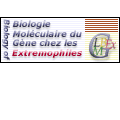
|
|















|
International Summer School
From Genome to Life:
Structural, Functional and Evolutionary approaches
DUCHAUD Eric |
|
URA2171 Du CNRS, Laboratoire de Génomique Des Microorganismes Pathogènes, Institut Pasteur, Structure Et Dynamique Des Génomes, 25 Rue Du Dr. Roux, Paris 75724, France title: Analysis of the genome of Photorhabdus luminescens, an endosymbiont of entomopathogenic nematodes The bacterium Photorhabdus luminescens is an insect pathogen that lives in symbiosis in the intestine of a nematode. The nematode is feeding on insect larvae : the worm creates small lesions in the insect larvae,then these are quickly killed by the bacterium. The is an important biotechnological research interest in the study of Photorhabdus luminescens as it produces active toxins against many insects, but also antibiotics and various enzymes. In addition, this microorganism is closely related to E. coli wich is very helpfull in the study of this bacterium. The sequencing of the complete genome (5.7 Mb) of Photorhabdus luminescens was carried out. The analysis of his genome content was performed and has revealed features important for virulence like different antibiotics biosynthesis loci, secreated proteins, iron capture system and a large amount of toxins. Genome organisation i.e repeated sequence, regions acquired by horizontal gene transfer will olso be presented. |